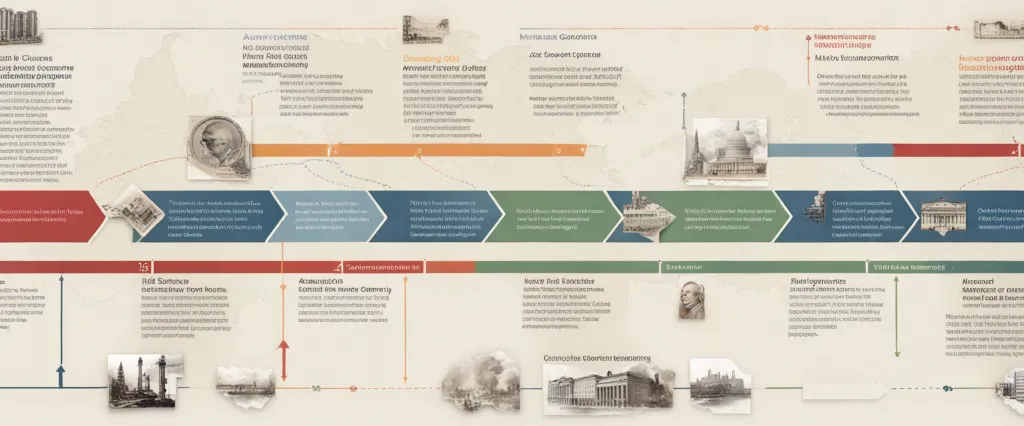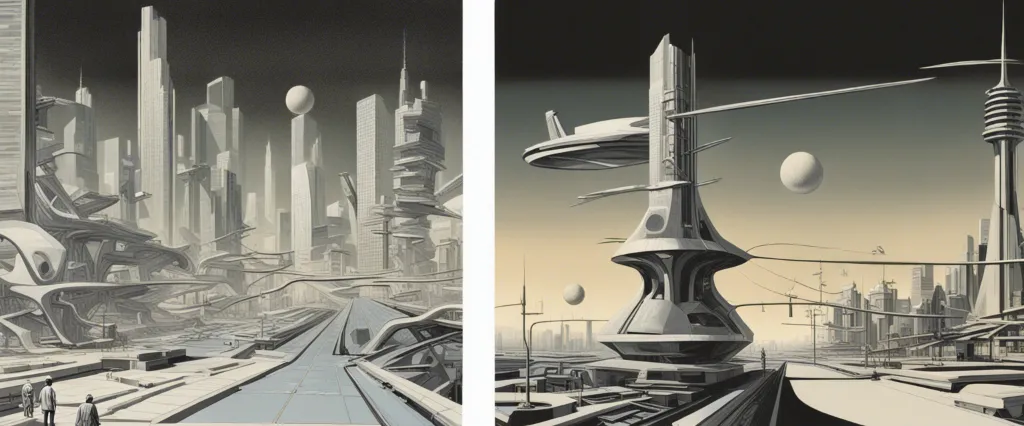In “The Rise and Fall of American Growth,” renowned economist Robert J. Gordon explores the remarkable advancements that fueled America’s unprecedented economic expansion between 1870 and 1970. Gordon meticulously examines the critical factors behind this period of rapid growth, such as technological innovations, demographic shifts, and institutional changes. However, he also takes a sobering look at the challenges the U.S. faces today, questioning whether such remarkable progress can be sustained in the face of current economic realities and prevailing headwinds. As a distinguished professor of economics at Northwestern University, Robert J. Gordon brings invaluable expertise to his comprehensive analysis of America’s past prosperity and its potential future limitations.
Chapter 1: Introduction
Chapter 1: Introduction of the book The Rise and Fall of American Growth by Robert J. Gordon provides an overview of the fundamental concepts and argument that permeate the book. The chapter seeks to establish a context for analyzing the major developments that have shaped the American economy from the late 19th century to the present.
Gordon asserts that the period between 1870 and 1970 was a unique era of transformation and unprecedented economic growth in the United States, driven by revolutionary technological advancements. This era witnessed profound changes in almost every facet of American life, including transportation, communication, healthcare, and overall living standards. Gordon refers to this era as the “special century.”
However, the author argues that since 1970, the U.S. has experienced a significant slowdown in economic growth due to a combination of factors, including diminishing returns on technological innovations and adverse demographic trends such as an aging population. Gordon contends that the present and future conditions differ greatly from the transformative forces that characterized the special century. He emphasizes the importance of recognizing these differences to understand the limitations of current and future economic growth.
Gordon introduces the concept of “solow residual” as a measure of technological progress. This concept measures the portion of economic growth that cannot be attributed to capital and labor inputs alone, representing the technological advancements that contribute to productivity gains. The author suggests that the rate of progress in this solow residual has significantly declined since the early 1970s.
In summary, Chapter 1 serves as an introduction to the book by highlighting the unique period of remarkable economic growth in American history and setting the stage for the subsequent exploration of the factors that fueled this growth, the challenges faced in recent decades, and the implications for future economic progress.
Chapter 2: The Invention Factory
Chapter 2 of “The Rise and Fall of American Growth” by Robert J. Gordon, titled “The Invention Factory,” explores the historical roots of the Second Industrial Revolution and its impact on American living standards. The chapter focuses on the transformative period from 1870 to 1915, which saw a surge of innovations and technological progress.
Gordon begins by explaining how the development of new industries and technologies during this era, such as electric power, chemicals, and internal combustion engines, laid the groundwork for the remarkable economic growth and improvements in people’s daily lives. The author emphasizes the importance of innovations like the telephone, typewriter, and the sewing machine, which drastically facilitated communication and mechanized previously labor-intensive tasks.
Furthermore, the chapter highlights the pivotal role of inventors, entrepreneurs, and corporate leaders in driving this immense wave of technological advancement. Notable figures such as Alexander Graham Bell, Thomas Edison, and Henry Ford are discussed, showcasing their significant contributions to American productivity and the overall economy.
Gordon also delves into the changes these inventions brought to household productivity, work environments, and urbanization patterns. He paints a vivid picture of the impact on consumers, from the rise of department stores and ready-made clothing to the growing convenience of home appliances. Additionally, industrial expansion led to an influx of people into booming urban areas, transforming American society and creating social challenges.
However, despite the unparalleled period of progress, Gordon highlights the limitations and drawbacks of these advancements. He explores how energy constraints, environmental concerns, monopolies, and labor exploitation posed significant obstacles to continued growth and societal welfare.
In conclusion, Chapter 2 illustrates the Second Industrial Revolution’s profound impact on American society and captures the excitement and challenges that accompanied this groundbreaking period of innovation and technological change.
Chapter 3: The Great Leap Forward
Chapter 3 of “The Rise and Fall of American Growth” by Robert J. Gordon, titled “The Great Leap Forward,” explores the economic and technological advancements that took place in the United States between the late 19th century and the early 20th century.
At the turn of the century, America experienced a period of unprecedented progress and innovation. The chapter begins by describing the impact of the second Industrial Revolution, characterized by breakthroughs in electricity, the telephone, chemicals, and petroleum. These advancements contributed to a significant increase in productivity, improving the overall standard of living for Americans.
The chapter further highlights the transformative effects of electrification. The widespread adoption of electricity allowed for the invention of various household appliances and gadgets, significantly enhancing the convenience and comfort of everyday life. It also led to the electrification of factories, facilitating mass production and further bolstering the nation’s industrial output.
Moreover, Gordon emphasizes the importance of public health improvements during this time. The chapter details the introduction of modern sanitation practices, such as the development of clean water systems, sewage treatment, and improved personal hygiene. These advancements played a crucial role in reducing mortality rates and improving general health conditions in the United States.
Furthermore, the author discusses the impact of the transportation revolution. The rise of the automobile, new road networks, and the expansion of railways revolutionized the movement of people and goods across the country. This led to increased mobility and facilitated a boom in construction, particularly in the suburbs.
Overall, Chapter 3 highlights the technological advancements and societal changes that occurred during the “Great Leap Forward” in the United States. From electrification to improved public health and transportation infrastructure, these developments set the stage for a significant increase in living standards and progress during the early 20th century.
Chapter 4: A Special Century

Chapter 4 of “The Rise and Fall of American Growth” by Robert J. Gordon, titled “A Special Century,” explores the period of exceptional economic growth and technological advancements in the United States from 1870 to 1970.
Gordon underscores that this century experienced an extraordinary burst of potential compared to any period before or since, referred to as the “special century.” The chapter’s goal is to investigate the key factors that drove this remarkable growth and comprehend the implications for future progress.
During this period, the United States experienced substantial improvements in living standards, fueled by transformative inventions and innovations. Gordon highlights several key inventions that shaped this era, including electric power, the telephone, and indoor plumbing. These advances not only increased productivity but also significantly enhanced daily life, leading to an improved quality of living for the average American.
Furthermore, the chapter delves into the profound impact of the Second Industrial Revolution, which involved the ascendancy of manufacturing, mass consumption, and the expansion of electricity, the internal combustion engine, and chemical industries. These developments initiated a wave of technological progress and economic growth, leading to an unprecedented rise in output per capita.
Gordon also emphasizes the necessary demographic and social changes that supported this special century. Immigration played a significant role in expanding the labor supply, while the urbanization and rise of the middle class further accelerated economic growth.
Although acknowledging that these advancements have brought numerous benefits, Gordon reminds readers of the challenges faced during this period, such as the environmental consequences of industrialization and the inequality gap that emerged. These considerations demonstrate that while the special century delivered substantial progress, it was not without difficulties.
Overall, Chapter 4 of “The Rise and Fall of American Growth” presents an analysis of the exceptional period of economic growth and technological change witnessed in the United States from 1870 to 1970. By uncovering the key inventions, societal shifts, and challenges during this time, Gordon offers insight into the drivers behind this unique developmental phase and its lasting influence on American society.
Chapter 5: Inequality and Growth
Chapter 5 of “The Rise and Fall of American Growth” by Robert J. Gordon focuses on the relationship between inequality and economic growth in the United States. The chapter argues that economic inequality has detrimental effects on overall economic growth and societal well-being.
Gordon starts by discussing the rise of inequality in the late 1970s and its persistence until the present. He highlights the role of globalization, technological progress, and changes in labor market policies as key factors contributing to growing inequality. The chapter then delves into the consequences of this inequality, emphasizing that it has not only caused income disparities but has also hindered productivity and economic growth.
The author points out that excessive inequality reduces political stability, weakens social cohesion, and limits opportunities for upward mobility. Gordon argues that the concentration of wealth and income in the hands of a few hinders overall consumption and investment, leading to slower economic expansion. He illustrates this through the decline in rates of innovation, entrepreneurship, and business dynamism since the 1970s.
Additionally, the chapter highlights how inequality exacerbates educational disparities, limiting opportunities for socio-economic advancement. As children from disadvantaged backgrounds face increased challenges in accessing quality education, their potential contributions to economic growth are hindered.
Gordon concludes the chapter by noting that reducing inequality requires a combination of policies aimed at increasing educational opportunities, strengthening worker bargaining power, and implementing redistributive measures. He emphasizes that addressing inequality is crucial for sustained economic growth and the well-being of society as a whole.
In summary, Chapter 5 of “The Rise and Fall of American Growth” examines the negative relationship between inequality and economic growth in the United States. It emphasizes how inequality hampers consumption, innovation, and investment, thus hindering productivity and overall societal well-being. The chapter underscores the importance of implementing policies that address inequality to ensure long-term economic prosperity.
Chapter 6: The Headwinds of Technological Stagnation
Chapter 6 of “The Rise and Fall of American Growth” by Robert J. Gordon explores the concept of technological stagnation and its impact on the American economy. The chapter argues that the rapid growth and development experienced by the United States between 1870 and 1970 was a unique period in history, and that subsequent technological advancements have not been able to match the transformative effects of earlier innovations.
Gordon begins by examining the reasons behind the slowdown in productivity growth since the 1970s. He highlights how the technological breakthroughs of the earlier era, such as electricity, automobiles, and indoor plumbing, brought dramatic improvements in living standards and productivity, while recent technological advancements, such as the internet and smartphones, have not had the same level of impact. He attributes this to a lack of significant innovations in key sectors that drive economic growth, such as healthcare, education, and transportation.
The chapter also explores the challenges posed by demographic shifts, focusing particularly on the aging population and its potential impact on productivity and economic growth. Gordon argues that an aging population will likely lead to a decrease in labor force participation and productivity, as older workers are less productive and spend fewer years in the workforce.
Additionally, the chapter examines the role of the education system and its failure to adequately prepare workers for the demands of a technologically advanced economy. It highlights how the US education system has struggled to adapt to the changing needs of the workforce, leading to a mismatch between the skills of workers and the skills demanded by employers.
Overall, Chapter 6 emphasizes the need for significant technological innovations in sectors beyond information technology and stresses the importance of addressing demographic challenges and improving the education system to drive future economic growth in the United States.
Chapter 7: Education: The Hidden Transformation
Chapter 7 of “The Rise and Fall of American Growth” by Robert J. Gordon focuses on the transformation of education in the United States between 1870 and 1940. This period witnessed significant developments in primary, secondary, and higher education, which played a crucial role in the country’s transformative economic growth.
The chapter begins by highlighting the expansion of the education system during this period. Universal, compulsory primary education increased school enrollment rates dramatically. Moreover, the growth of high schools led to a surge in secondary education, allowing more young Americans to pursue further education beyond the primary level. This expansion was aided by progressive educational reforms and the introduction of kindergartens and junior high schools.
Gordon explores how these advancements in education were closely linked to economic growth. The increased schooling led to improved literacy rates, essential for the modern workforce. Moreover, the emphasis on technical and vocational training in high schools equipped individuals with skills necessary for industrialization and facilitated the transition from agriculture to industry. Furthermore, the rise of universities and the emphasis on research and development promoted technological breakthroughs and innovation.
The chapter also addresses the challenges faced by African Americans in accessing equal education during this period. Despite some progress in the educational opportunities for African Americans, such as the establishment of historically black colleges, racial segregation and discriminatory policies limited their access to quality education and perpetuated social and economic disparities.
Overall, Chapter 7 underscores the crucial role of education in shaping America’s rapid economic growth between 1870 and 1940. The expansion of the education system and the focus on literacy, technical skills, and research laid the foundation for the nation’s progress and development.

Chapter 8: The Outlook for Growth
Chapter 8 of “The Rise and Fall of American Growth” by Robert J. Gordon focuses on the outlook for economic growth in the United States. The chapter begins by acknowledging the challenges the country faces, such as slow productivity growth, rising inequality, and the threat of environmental damage.
Gordon argues that the future economic growth in the United States is likely to be slower compared to the rapid advancements seen in the past. He highlights the importance of technological innovations, which have been the primary driver of growth over the last century. However, he suggests that the low-hanging fruit of technological progress has already been picked, leaving fewer opportunities for transformative inventions that can significantly boost productivity.
Another factor that Gordon discusses is the impact of an aging population on growth. As the baby boomer generation retires, there will be a decline in the active labor force and an increased strain on government finances. This could result in decreased investment in innovation and infrastructure, further impeding future growth.
Furthermore, Gordon explores the role of inequality in dampening economic growth. He argues that the rising income disparities witnessed in recent decades have hindered widespread access to education, healthcare, and other key services, limiting opportunities for social mobility and economic advancement.
Finally, the chapter delves into the environmental challenges that the world, including the United States, is facing. The pursuit of economic growth has led to environmental degradation and climate change, presenting both economic and social risks that cannot be ignored.
In essence, Chapter 8 of “The Rise and Fall of American Growth” paints a picture of slower economic growth for the United States in the future, primarily due to diminishing technological progress, an aging population, income inequality, and environmental constraints. It emphasizes the need to address these challenges in order to navigate and shape a sustainable and prosperous future for the nation.
After Reading
In conclusion, Robert J. Gordon’s book, The Rise and Fall of American Growth, provides a comprehensive analysis of the economic history of the United States, encompassing technological advancements, productivity growth, and their impact on living standards. By extensively examining various eras of American history, Gordon argues that the remarkable period of growth from 1870 to 1970, characterized by transformative inventions such as electricity and indoor plumbing, is unlikely to be repeated in the future. He emphasizes the need for realistic expectations regarding future economic growth, addressing issues such as inequality, education, and environmental sustainability. Overall, The Rise and Fall of American Growth offers a thought-provoking perspective on the challenges and opportunities that lie ahead for the American economy, urging readers to carefully consider the factors that have shaped its past to inform future policy-making and decision-making processes.
1. “The Great Leveler: Violence and the History of Inequality from the Stone Age to the Twenty-First Century” by Walter Scheidel – This book examines the role of violence and societal disruptions in shaping economic inequality throughout history. It offers a comprehensive analysis of how various factors have contributed to the rise and fall of economic growth.
2. “The Fourth Industrial Revolution” by Klaus Schwab – In this book, Schwab explores the impact of technological advancements on the global economy. It delves into how artificial intelligence, robotics, and other emerging technologies are transforming industries and societies, highlighting both the potential benefits and challenges that come with such changes.
3. Capital in the Twenty-First Century” by Thomas Piketty – Piketty’s seminal work examines the historical patterns of wealth and income inequality. By analyzing vast sets of economic data, he presents a comprehensive picture of how economic systems perpetuate inequality and offers potential policy solutions to address these issues.
4. The Innovators: How a Group of Hackers, Geniuses, and Geeks Created the Digital Revolution” by Walter Isaacson – Isaacson tells the captivating story of the individuals who played key roles in shaping the digital revolution, from pioneers like Ada Lovelace and Alan Turing to modern-day tech visionaries. The book explores the interplay between innovation, technology, and economic growth.
5. “The Age of Sustainable Development” by Jeffrey D. Sachs – In this book, Sachs outlines a comprehensive blueprint for achieving sustainable development in the twenty-first century. He analyzes the interconnections between economic growth, social inclusion, and environmental sustainability, offering insights into how societies can address the challenges of our time and promote inclusive growth.




